School of the Future: A Comprehensive Study on the Effectiveness of Augmented Reality as a Tool for Primary School Children’s Education
Abstract
:1. Introduction
- The attitude and behavior of the students towards AR learning methods in contrast to traditional methods.
- The interest of students and motivation towards AR-based learning activities and traditional learning methods.
- The learning achievements of students through the advanced techniques of AR compared to traditional learning methods.
- Parents’ and teachers’ response towards the potentials of implementing AR techniques in student’s academics at early ages.
- Mobile-based AR techniques are used to develop four applications for primary school students’ learning purposes. With the help of these applications, students can learn and enjoy their subjects through android phones or tablets.
- Proposed applications are based on the academic books of grade one that fulfills all the curriculum requirements of the targeted section. Students can observe the abstract concepts of their academic books through their eyes with mobile-based AR technology in the form of 3D virtual content.
- The PEQs are built in each application used to measure the learning efficiency of these AR-based learning methods. Students learning achievements are tested using these quizzes without conducting any theoretical physical exam.
- Three different types of learning activities are performed to measure the effectiveness of AR technology in students’ academic activities as compared to the traditional methods of learning, especially at early ages. The above-mentioned research questions are discussed in detail to evaluate the effectiveness of AR-based learning methods.
2. Related Work
2.1. AR in Education
2.2. Learning Content Understanding
2.3. Improve Collaboration
2.4. Increase Student Motivation
3. Methodology
3.1. Design and Development Process
3.2. Applications Workflow
- Using an android phone, IOS, or tablet, a target book page or animal image is scanned.
- Features of the target page are stored in the Vuforia database.
- Obtained features are compared with the pre-stored features of the target images in the Vuforia database.
- When the features match up with the database, the application augments virtual content on the surface of that image target.
- The AR application visualizes the learning content, graphics with the image captured by the smartphone.
3.2.1. Nursery Rhyme
3.2.2. AR Numbers
3.2.3. AR Zoo
3.2.4. AR Globe
4. Experimentation and Results
4.1. Experimental Procedure and Participants
4.2. Learning Materials
4.3. Results Analysis and Discussion
4.3.1. The Attitude of Students towards AR
4.3.2. Learning Motivation
4.3.3. Learning Achievements
4.3.4. Response from Teachers and Parents
5. Conclusions and Future Directions
Supplementary Materials
Author Contributions
Funding
Data Availability Statement
Conflicts of Interest
References
- Poux, F.; Valembois, Q.; Mattes, C.; Kobbelt, L.; Billen, R. Initial User-Centered Design of a Virtual Reality Heritage System: Applications for Digital Tourism. Remote Sens. 2020, 12, 2583. [Google Scholar] [CrossRef]
- Quintero, J.; Baldiris, S.; Rubira, R.; Cerón, J.; Velez, G. Augmented reality in educational inclusion. A systematic review on the last decade. Front. Psychol. 2019, 10, 1835. [Google Scholar] [CrossRef] [PubMed] [Green Version]
- Čejka, J.; Bruno, F.; Skarlatos, D.; Liarokapis, F. Detecting square markers in underwater environments. Remote Sens. 2019, 11, 459. [Google Scholar] [CrossRef] [Green Version]
- Alidoost, F.; Arefi, H.; Tombari, F. 2D image-to-3D model: Knowledge-based 3D building reconstruction (3DBR) using single aerial images and convolutional neural networks (CNNs). Remote Sens. 2019, 11, 2219. [Google Scholar] [CrossRef] [Green Version]
- Azuma, R.T. A survey of augmented reality. Presence Teleoperators Virtual Environ. 1997, 6, 355–385. [Google Scholar] [CrossRef]
- Koh, R.K.C.; Duh, H.B.-L.; Gu, J. An integrated design flow in user interface and interaction for enhancing mobile AR gaming experiences. In Proceedings of the 2010 IEEE International Symposium on Mixed and Augmented Reality-Arts, Media, and Humanities, Seoul, Korea, 13–16 October 2010. [Google Scholar]
- Johnson, L.; Levine, A.; Smith, R.; Stone, S. The 2010 Horizon Report; ERIC: 2010. The 2010 Horizon Report; New Media Consortium: Austin, TX, USA, 2010. [Google Scholar]
- Fan, Y.; Feng, Z.; Mannan, A.; Khan, T.U.; Shen, C.; Saeed, S. Estimating tree position, diameter at breast height, and tree height in real-time using a mobile phone with RGB-D SLAM. Remote Sens. 2018, 10, 1845. [Google Scholar] [CrossRef] [Green Version]
- Boonbrahm, S.; Kaewrat, C.; Boonbrahm, P. Using augmented reality technology in assisting english learning for primary school students. In International Conference on Learning and Collaboration Technologies; Springer: Berlin/Heidelberg, Germany, 2015. [Google Scholar]
- Chang, G.; Morreale, P.; Medicherla, P. Applications of augmented reality systems in education. In Proceedings of the Society for Information Technology & Teacher Education International Conference, San Diego, CA, USA, 29 March–2 April 2010. [Google Scholar]
- Brookes, F.; Zazryn, T. Learning: Primary and Secondary School Years. Raising Children Network. Available online: https://raisingchildren.net.au/school-age/school-learning/learning-ideas/learning-school-years (accessed on 24 June 2019).
- Divjak, B.; Tomić, D. The impact of game-based learning on the achievement of learning goals and motivation for learning mathematics-literature review. J. Inf. Organ. Sci. 2011, 35, 15–30. [Google Scholar]
- De Freitas, S.; Rebolledo-Mendez, G.; Liarokapis, F.; Magoulas, G.; Poulovassilis, A. Learning as immersive experiences: Using the four-dimensional framework for designing and evaluating immersive learning experiences in a virtual world. Br. J. Educ. Technol. 2010, 41, 69–85. [Google Scholar] [CrossRef]
- Chao, P.-Y.; Chen, G.-D. Augmenting paper-based learning with mobile phones. Interact. Comput. 2009, 21, 173–185. [Google Scholar] [CrossRef]
- Huang, H.-W.; Wu, C.-W.; Chen, N.-S. The effectiveness of using procedural scaffoldings in a paper-plus-smartphone collaborative learning context. Comput. Educ. 2012, 59, 250–259. [Google Scholar] [CrossRef]
- Taketa, N.; Hayashi, K.; Kato, H.; Noshida, S. Virtual pop-up book based on augmented reality. In Symposium on Human Interface and the Management of Information; Springer: Berlin/Heidelberg, Germany, 2007. [Google Scholar]
- Hantono, B.S.; Nugroho, L.E.; Santosa, P.I. Meta-review of augmented reality in education. In Proceedings of the 2018 10th International Conference on Information Technology and Electrical Engineering (ICITEE), Bali, Indonesia, 24–26 July 2018. [Google Scholar]
- Nincarean, D.; Alia, M.B.; Halim, N.D.A.; Rahman, M.H.A. Mobile Augmented Reality: The potential for education. Procedia Soc. Behav. Sci. 2013, 103, 657–664. [Google Scholar] [CrossRef] [Green Version]
- Barreira, J.; Bessa, M.; Pereira, L.C.; Adão, T.; Peres, E.; Magalhães, L. MOW: Augmented Reality game to learn words in different languages: Case study: Learning English names of animals in elementary school. In Proceedings of the 7th Iberian Conference on Information Systems and Technologies (CISTI 2012), Madrid, Spain, 20–23 June 2012. [Google Scholar]
- Radu, I. Why should my students use AR? A comparative review of the educational impacts of augmented-reality. In Proceedings of the 2012 IEEE International Symposium on Mixed and Augmented Reality (ISMAR), Atlanta, GA, USA, 5–8 November 2012. [Google Scholar]
- Tonnis, M.; Lochhead, I.; Madden, M.; Christophe, S.; Devaux, A.; Pettit, C.; Hedley, N. Experimental evaluation of an augmented reality visualization for directing a car driver’s attention. In Proceedings of the Fourth IEEE and ACM International Symposium on Mixed and Augmented Reality (ISMAR’05), Vienna, Austria, 5–8 October 2005. [Google Scholar]
- Çöltekin, A.; Lochhead, I.; Madden, M.; Christophe, S.; Devaux, A.; Pettit, C.; Hedley, N. Extended reality in spatial sciences: A review of research challenges and future directions. ISPRS Int. J. Geo-Inf. 2020, 9, 439. [Google Scholar] [CrossRef]
- Keil, J.; Edler, D.; Dickmann, F. Preparing the HoloLens for user studies: An augmented reality interface for the spatial adjustment of holographic objects in 3D indoor environments. KN-J. Cartogr. Geogr. Inf. 2019, 69, 205–215. [Google Scholar] [CrossRef] [Green Version]
- Tomi, A.B.; Rambli, D.R.A. An interactive mobile augmented reality magical playbook: Learning number with the thirsty crow. Procedia Comput. Sci. 2013, 25, 123–130. [Google Scholar] [CrossRef] [Green Version]
- Midak, L.Y.; Kravets, I.V.; Kuzyshyn, O.V.; Berladyniuk, K.V.; Buzhdyhan, K.V.; Baziuk, L.V.; Uchitel, A.D. Augmented reality in process of studying astronomic concepts in primary school. In Proceedings of the 3rd International Workshop on Augmented Reality in Education (AREdu 2020), Kryvyi Rih, Ukraine, 13 May 2020. [Google Scholar]
- Zarzuela, M.M.; Pernas, F.J.D.; Martínez, L.B.; Ortega, D.G.; Rodríguez, M.A. Mobile serious game using augmented reality for supporting children’s learning about animals. Procedia Comput. Sci. 2013, 25, 375–381. [Google Scholar] [CrossRef] [Green Version]
- Billinghurst, M. Augmented reality in education. New Horiz. Learn. 2002, 12, 1–5. [Google Scholar]
- Radu, I. Augmented reality in education: A meta-review and cross-media analysis. Pers. Ubiquitous Comput. 2014, 18, 1533–1543. [Google Scholar] [CrossRef]
- Shoaib, H.; Jaffry, S.W. A survey of augmented reality. In Proceedings of the International Conference on Virtual and Augmented Reality (ICV AR 2015), Brisbane, Australia, 25–27 March 2015. [Google Scholar]
- Sahin, D.; Yilmaz, R.M. The effect of Augmented Reality Technology on middle school students’ achievements and attitudes towards science education. Comput. Educ. 2020, 144, 103710. [Google Scholar] [CrossRef]
- De Lisi, R.; Wolford, J.L. Improving children’s mental rotation accuracy with computer game playing. J. Genet. Psychol. 2002, 163, 272–282. [Google Scholar] [CrossRef]
- Merians, A.S.; Jack, D.; Boian, R.; Tremaine, M.; Burdea, G.C.; Adamovich, S.V.; Poizner, H. Virtual reality–augmented rehabilitation for patients following stroke. Phys. Ther. 2002, 82, 898–915. [Google Scholar] [CrossRef] [Green Version]
- Tang, A.; Owen, C.; Biocca, F.; Mou, W. Comparative effectiveness of augmented reality in object assembly. In Proceedings of the SIGCHI Conference on Human Factors in Computing Systems, Lauderdale, FL, USA, 5–10 March 2003. [Google Scholar]
- Lin, C.-Y.; Chai, H.C.; Wang, J.Y.; Chen, C.J.; Liu, Y.H.; Chen, C.W.; Huang, Y.M. Augmented reality in educational activities for children with disabilities. Displays 2016, 42, 51–54. [Google Scholar] [CrossRef]
- Chang, Y.-J.; Chang, C.S.; Lin, C.Y.; Wang, Y.Z. Investigating students’ perceived satisfaction, behavioral intention, and effectiveness of English learning using augmented reality. In Proceedings of the 2011 IEEE International Conference on Multimedia and Expo, Barcelona, Spain, 11–15 July 2011. [Google Scholar]
- Safar, A.H.; Al-Jafar, A.A.; Al-Yousefi, Z.H. The effectiveness of using augmented reality apps in teaching the English alphabet to kindergarten children: A case study in the State of Kuwait. EURASIA J. Math. Sci. Technol. Educ. 2016, 13, 417–440. [Google Scholar] [CrossRef]
- Rambli, D.R.A.; Matcha, W.; Sulaiman, S. Fun learning with AR alphabet book for preschool children. Procedia Comput. Sci. 2013, 25, 211–219. [Google Scholar] [CrossRef] [Green Version]
- Cieza, E.; Lujan, D. Educational mobile application of augmented reality based on markers to improve the learning of vowel usage and numbers for children of a kindergarten in Trujillo. Procedia Comput. Sci. 2018, 130, 352–358. [Google Scholar] [CrossRef]
- Nainggolan, E.R.; Asymar, H.H.; Nalendra, A.R.A.; Sulaeman, F.; Radiyah, U. The implementation of augmented reality as learning media in introducing animals for early childhood education. In Proceedings of the 2018 6th International Conference on Cyber and IT Service Management (CITSM), Parapat, Indonesia, 7–9 August 2018. [Google Scholar]
- Schnürer, R.; Dind, C.; Schalcher, S.; Tschudi, P.; Hurni, L. Augmenting Printed School Atlases with Thematic 3D Maps. Multimodal Technol. Interact. 2020, 4, 23. [Google Scholar] [CrossRef]
- Wiehr, F.; Daiber, F.; Kosmalla, F.; Krüger, A. ARTopos: Augmented reality terrain map visualization for collaborative route planning. In Proceedings of the 2017 ACM International Joint Conference on Pervasive and Ubiquitous Computing and Proceedings of the 2017 ACM International Symposium on Wearable Computers, Maui, HI, USA, 11–15 September 2017. [Google Scholar]
- Lindgren, R.; Moshell, J.M. Supporting children’s learning with body-based metaphors in a mixed reality environment. In Proceedings of the 10th International Conference on Interaction Design and Children, Ann Arbor, MI, USA, 20–23 June 2011. [Google Scholar]
- Sin, A.K.; Zaman, H.B. Live Solar System (LSS): Evaluation of an Augmented Reality book-based educational tool. In Proceedings of the 2010 International Symposium on Information Technology, Kuala Lumpur, Malaysia, 15–17 June 2010. [Google Scholar]
- Nischelwitzer, A.; Lenz, F.J.; Searle, G.; Holzinger, A. Some aspects of the development of low-cost augmented reality learning environments as examples for future interfaces in technology enhanced learning. In Proceedings of the International Conference on Universal Access in Human-Computer Interaction, Beijing, China, 22–27 July 2007. [Google Scholar]
- Quarles, J.; Lampotang, S.; Fischler, I.; Fishwick, P.; Lok, B. A mixed reality approach for merging abstract and concrete knowledge. In Proceedings of the 2008 IEEE Virtual Reality Conference, Reno, NV, USA, 8–12 March 2008. [Google Scholar]
- Freitas, R.; Campos, P. SMART: A SysteM of Augmented Reality for Teaching 2nd grade students. People Comput. XXII Cult. Creat. Interact. 2008, 22, 27–30. [Google Scholar]
- Morrison, A.; Oulasvirta, A.; Peltonen, P.; Lemmela, S.; Jacucci, G.; Reitmayr, G.; Juustila, A. Like bees around the hive: A comparative study of a mobile augmented reality map. In Proceedings of the SIGCHI Conference on Human Factors in Computing Systems, Boston, MA, USA, 4–9 April 2009. [Google Scholar]
- Matcha, W.; Rambli, D.R.A. Preliminary investigation on the use of augmented reality in collaborative learning. In Proceedings of the International Conference on Informatics Engineering and Information Science, Kuala Lumpur, Malaysia, 14–16 November 2011. [Google Scholar]
- Pathomaree, N.; Charoenseang, S. Augmented reality for skill transfer in assembly task. In Proceedings of the IEEE International Workshop on Robot and Human Interactive Communication 2005 (ROMAN 2005), Nashville, TN, USA, 13–15 August 2005. [Google Scholar]
- Lin, T.-J.; Duh, H.B.L.; Li, N.; Wang, H.Y.; Tsai, C.C. An investigation of learners’ collaborative knowledge construction performances and behavior patterns in an augmented reality simulation system. Comput. Educ. 2013, 68, 314–321. [Google Scholar] [CrossRef]
- Yoon, S.A.; Elinich, K.; Wang, J.; Steinmeier, C.; Tucker, S. Using augmented reality and knowledge-building scaffolds to improve learning in a science museum. Int. J. Comput.-Supported Collab. Learn. 2012, 7, 519–541. [Google Scholar] [CrossRef]
- Kaufmann, H.; Dünser, A. Summary of usability evaluations of an educational augmented reality application. In Proceedings of the International Conference on Virtual Reality, Beijing, China, 22–27 July 2007. [Google Scholar]
- Juan, C.M.; Toffetti, G.; Abad, F.; Cano, J. Tangible cubes used as the user interface in an augmented reality game for edutainment. In Proceedings of the 2010 10th IEEE International Conference on Advanced Learning Technologies, Sousse, Tunisia, 5–7 July 2010. [Google Scholar]
- Di Serio, Á.; Ibáñez, M.B.; Kloos, C.D. Impact of an augmented reality system on students’ motivation for a visual art course. Comput. Educ. 2013, 68, 586–596. [Google Scholar] [CrossRef] [Green Version]
- Chiang, T.H.; Yang, S.J.; Hwang, G.-J. An augmented reality-based mobile learning system to improve students’ learning achievements and motivations in natural science inquiry activities. J. Educ. Technol. Soc. 2014, 17, 352–365. [Google Scholar]
- Vincenzi, D.A.; Valimont, B.; Macchiarella, N.; Opalenik, C.; Gangadharan, S.N.; Majoros, A.E. The effectiveness of cognitive elaboration using augmented reality as a training and learning paradigm. In Proceedings of the Human Factors and Ergonomics Society Annual Meeting, Denver, CO, USA, 13–17 October 2003. [Google Scholar]
- Herpich, F.; Guarese, R.L.M.; Tarouco, L.M.R. A comparative analysis of augmented reality frameworks aimed at the development of educational applications. Creat. Educ. 2017, 8, 1433. [Google Scholar] [CrossRef] [Green Version]
- Agustina, W.; Sumarto, S.; Trisno, B. Augmented reality based on stem for supporting science literacy in vocational education. In Proceedings of the Journal of Physics: Conference Series, Crete, Greece, 9–15 June 2019. [Google Scholar]
- Simonetti Ibañez, A.; Figueras, J.P. Vuforia v1. 5 SDK: Analysis and Evaluation of Capabilities. Ph.D. Thesis, Universitat Politècnica de Catalunya, Barcelona, Spain, 2013. [Google Scholar]
- Kim, S.L.; Suk, H.J.; Kang, J.H.; Jung, J.M.; Laine, T.H.; Westlin, J. Using Unity 3D to facilitate mobile augmented reality game development. In Proceedings of the 2014 IEEE World Forum on Internet of Things (WF-IoT), Seoul, Korea, 6–8 March 2014. [Google Scholar]
- Khan, T.; Johnston, K.; Ophoff, J. The impact of an augmented reality application on learning motivation of students. Adv. Hum.-Comput. Interact. 2019, 2019, 7208494. [Google Scholar] [CrossRef] [Green Version]
- Lu, S.-J.; Liu, Y.-C. Integrating augmented reality technology to enhance children’s learning in marine education. Environ. Educ. Res. 2015, 21, 525–541. [Google Scholar] [CrossRef]
- Redondo, B.; Cózar-Gutiérrez, R.; González-Calero, J.A.; Ruiz, R.S. Integration of augmented reality in the teaching of English as a foreign language in early childhood education. Early Child. Educ. J. 2020, 48, 147–155. [Google Scholar] [CrossRef]
- Chen, C.-H.; Chou, Y.-Y.; Huang, C.-Y. An augmented-reality-based concept map to support mobile learning for science. Asia-Pac. Educ. Res. 2016, 25, 567–578. [Google Scholar] [CrossRef]
- McMillan, J.H.; Schumacher, S. Research in Education: Evidence-Based Inquiry, My Education Lab Series; Pearson: London, UK, 2010. [Google Scholar]
- Küçük, S.; Yilmaz, R.; Baydas, Ö.; Göktas, Y. Augmented reality applications attitude scale in secondary schools: Validity and reliability study. Egitim ve Bilim 2014, 39, 383–392. [Google Scholar] [CrossRef] [Green Version]
- Park, H.M. Comparing Group Means: T-Tests and One-Way ANOVA Using Stata, SAS, R, and SPSS; The University Information Techology Services (UITS) Center for Statistical and Mathematical Computing, Indiana University: Bloomington, IN, USA, 2009. [Google Scholar]
- Keller, J.M. Motivational Design for Learning and Performance: The ARCS Model Approach; Springer: Berlin/Heidelberg, Germany, 2009. [Google Scholar]
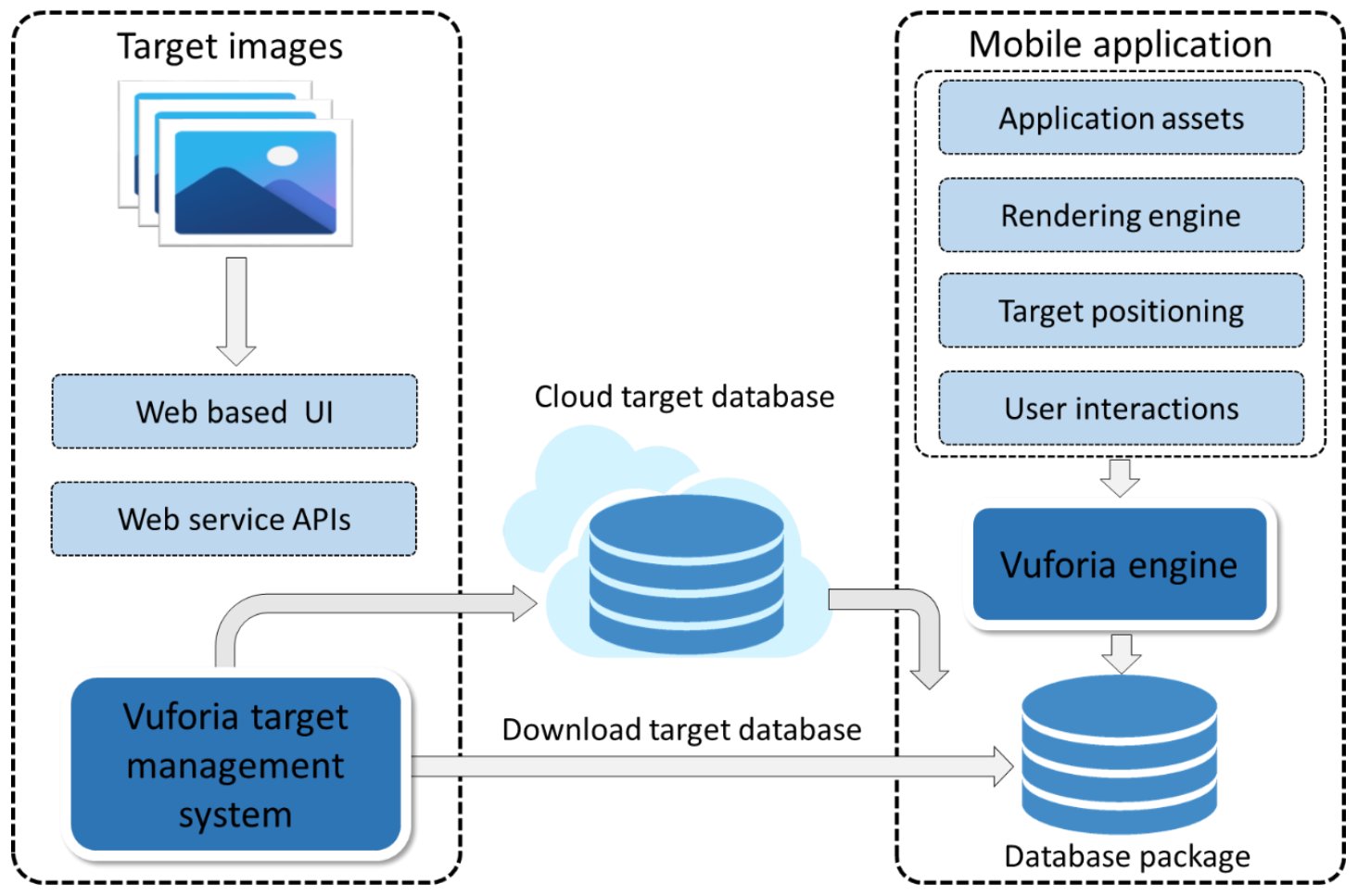


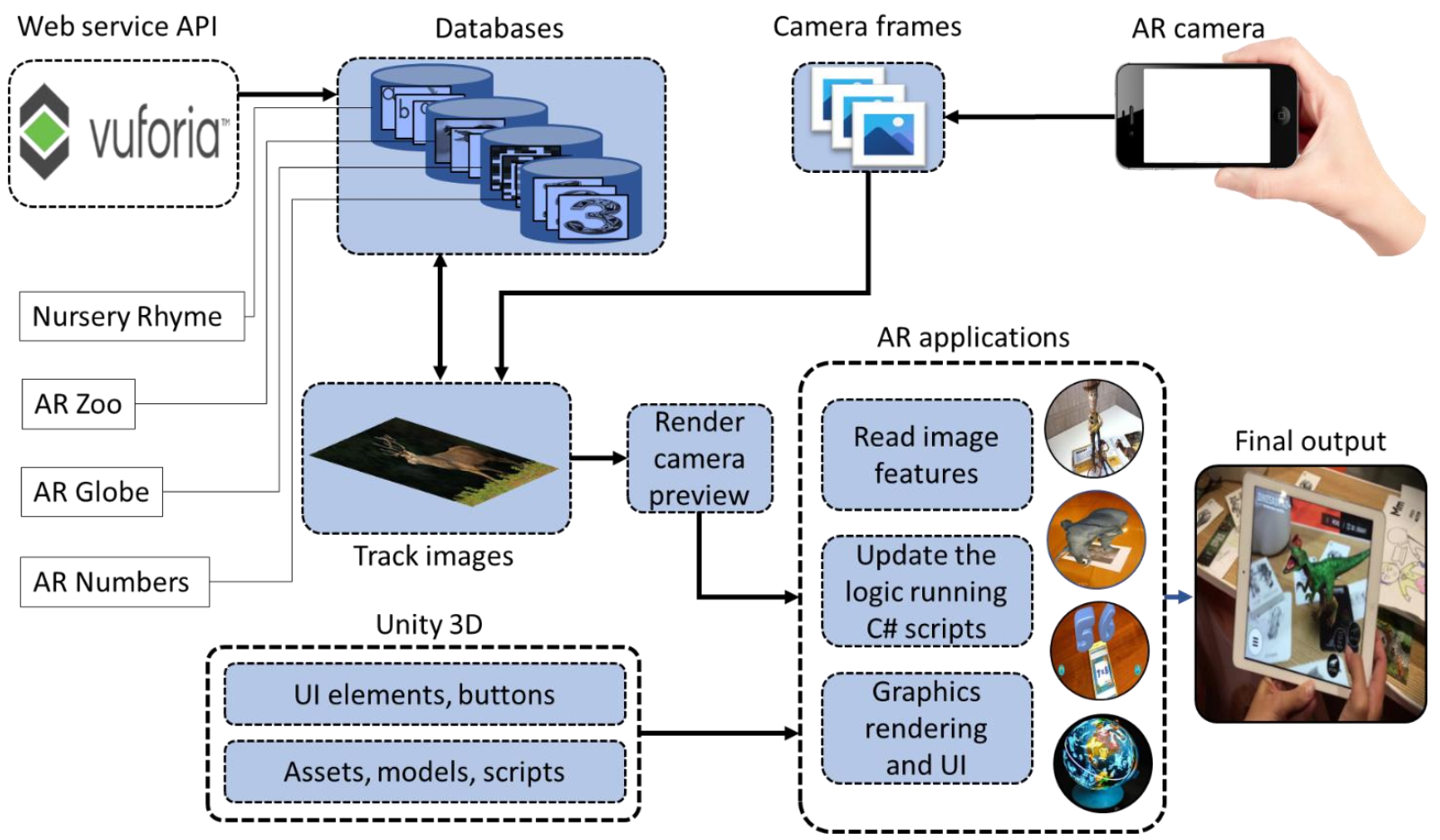
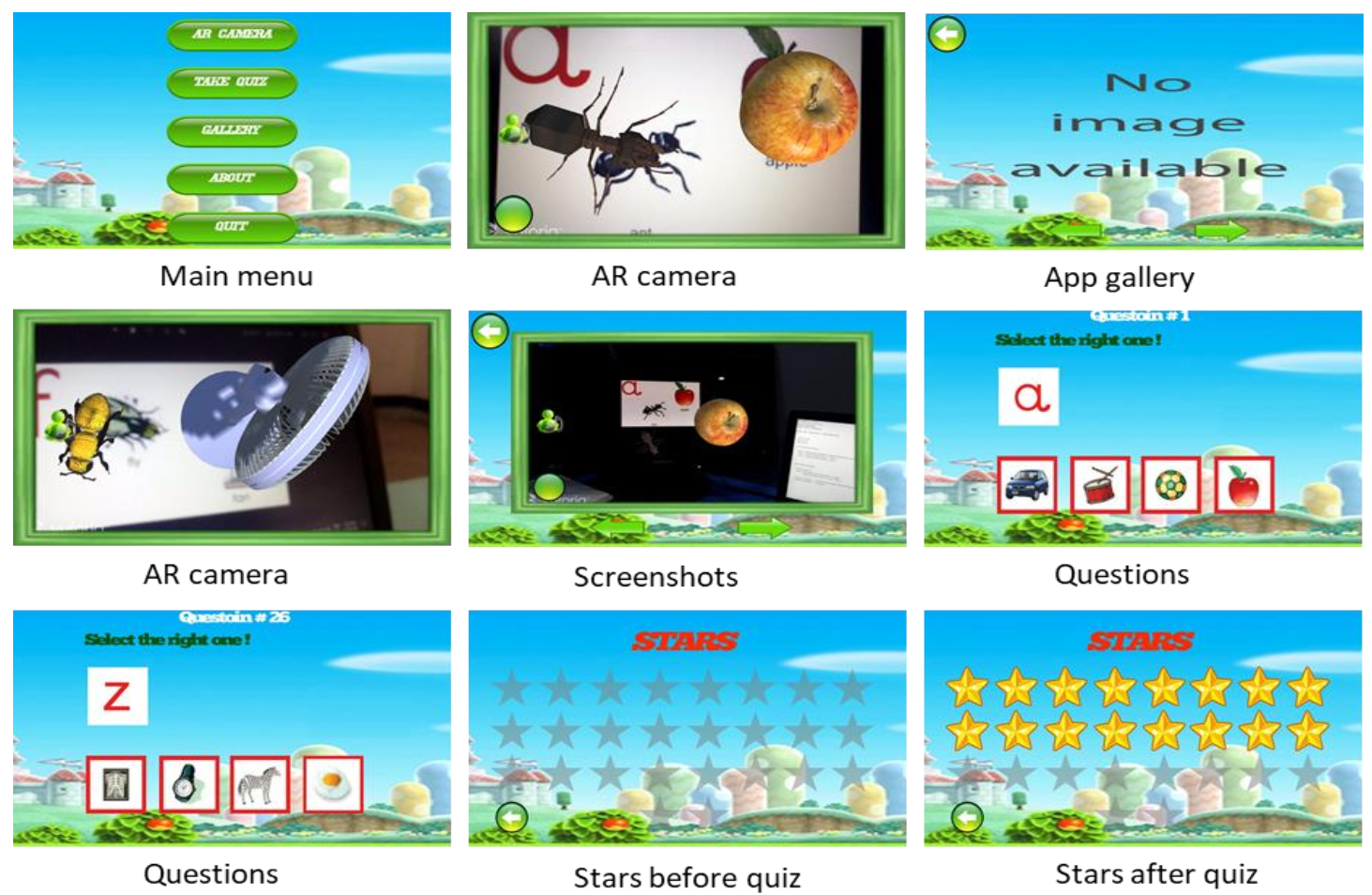
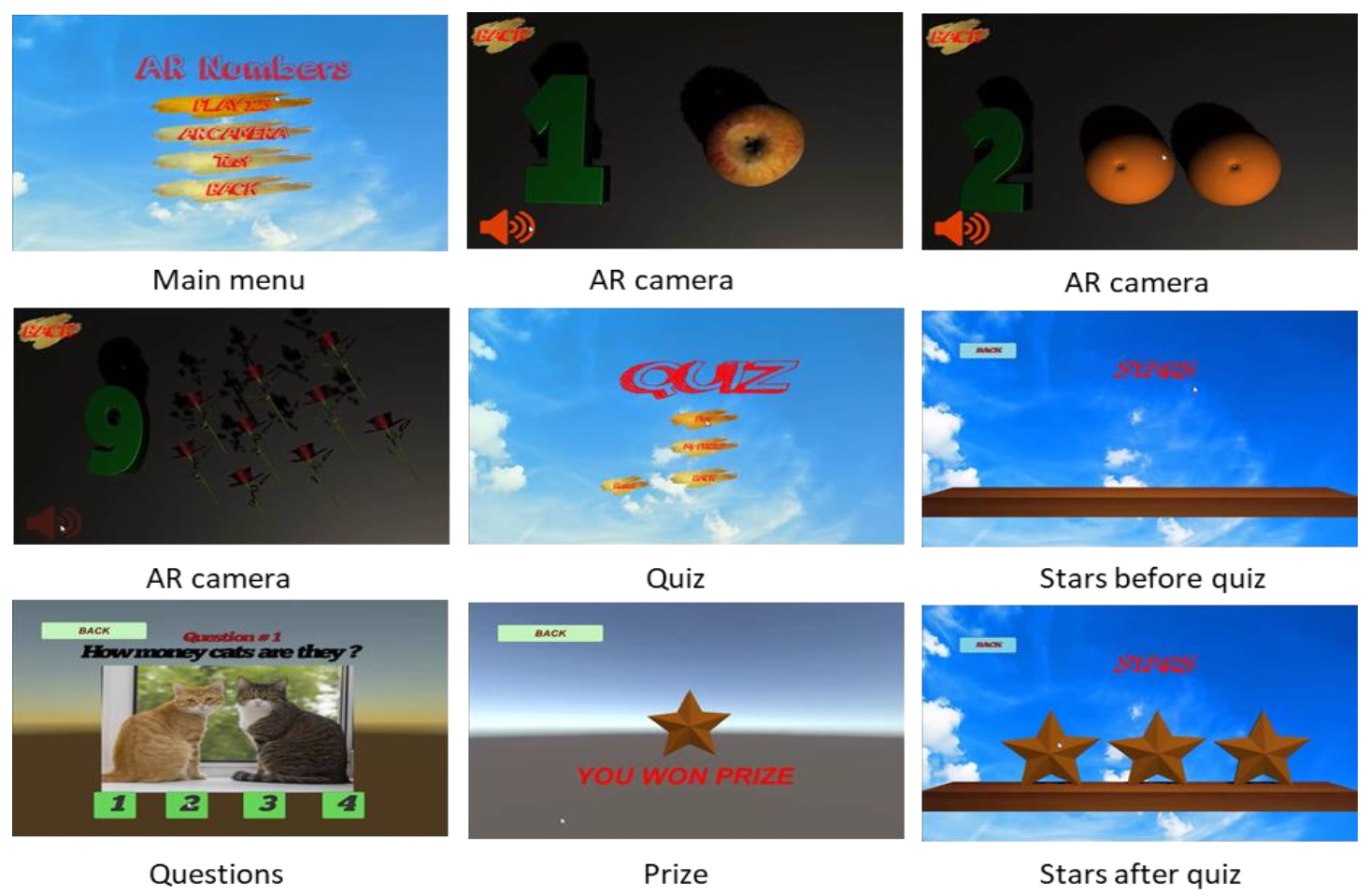
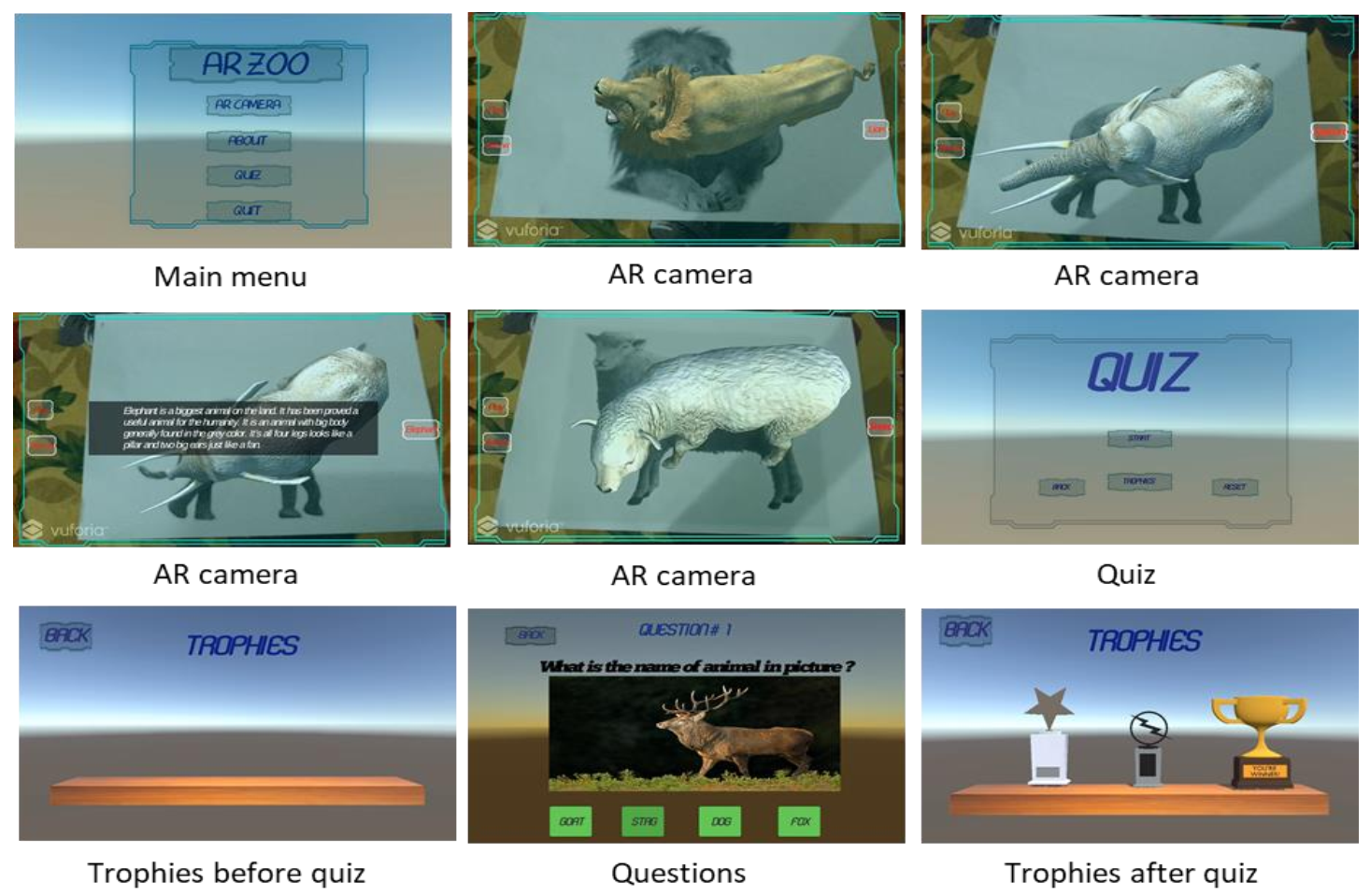
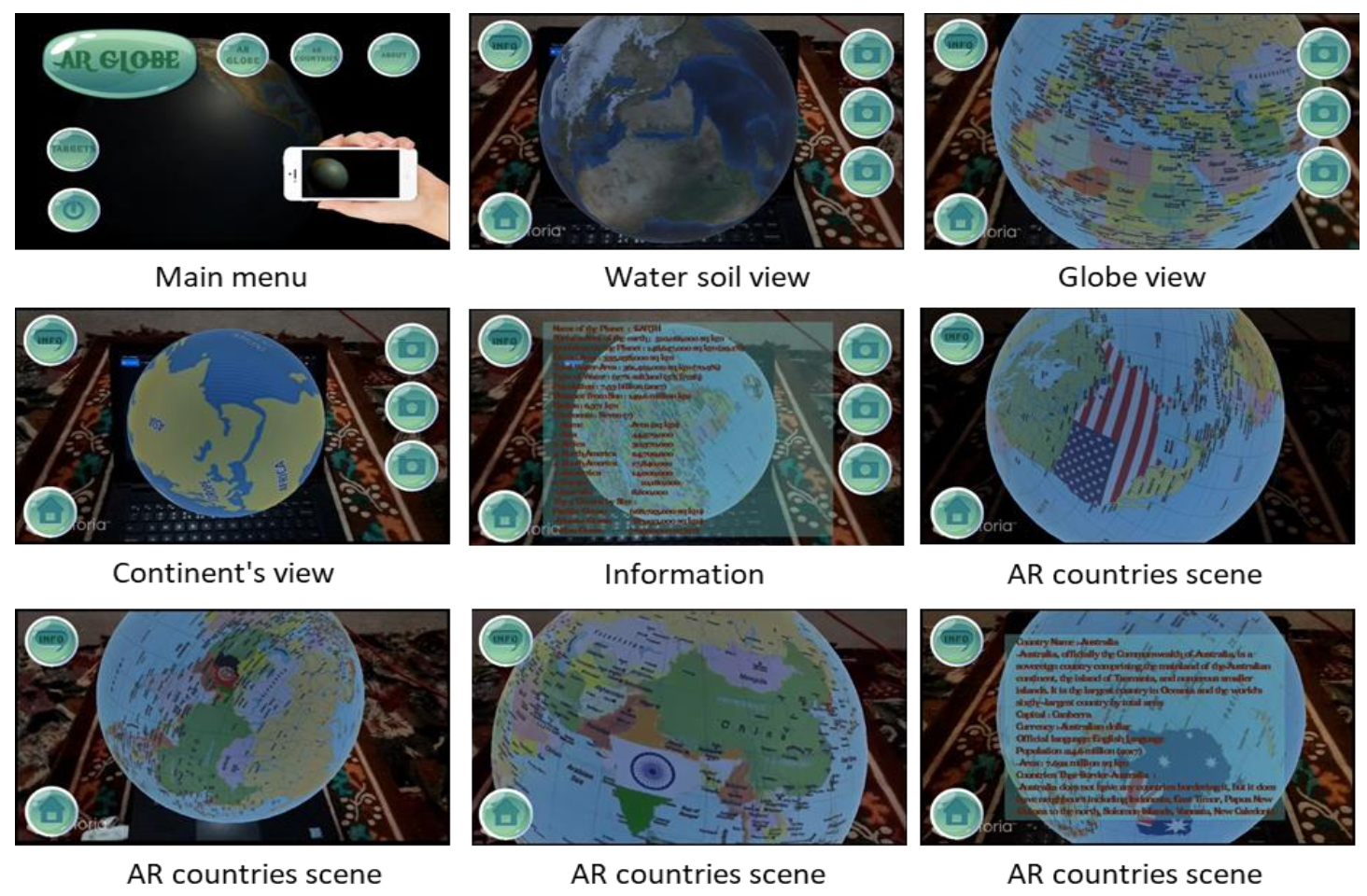
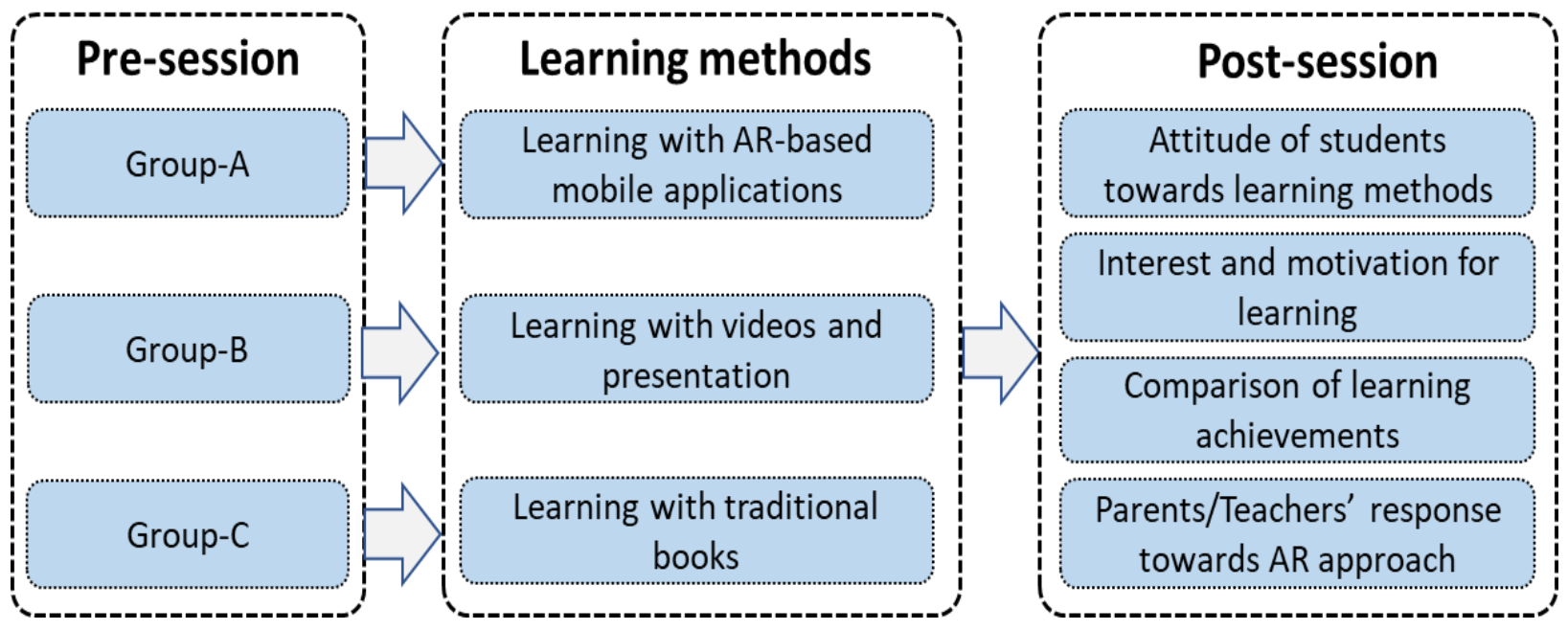

| Group | No. of Students | Boys:Girls | Mean | Standard Deviation |
|---|---|---|---|---|
| Group-A | 50 | 33:17 | 73.5 | 8.5 |
| Group-B | 50 | 28:22 | 75.1 | 9.2 |
| Group-C | 50 | 30:20 | 74.3 | 7.8 |
| Variable | Group | Mean | Standard Deviation | F-Value | p-Value |
|---|---|---|---|---|---|
| Willingness | Group-A | 4.36 | 0.65 | 137.21 | 2.40802 × 10−34 |
| Group-B | 2.54 | 0.75 | |||
| Group-C | 2.04 | 0.77 | |||
| Satisfaction | Group-A | 4.02 | 0.78 | 164.67 | 2.95426 × 10−38 |
| Group-B | 1.88 | 0.79 | |||
| Group-C | 1.54 | 0.61 | |||
| Anxiety | Group-A | 1.80 | 0.74 | 122.32 | 5.2641 × 10−32 |
| Group-B | 4.16 | 0.90 | |||
| Group-C | 3.98 | 0.83 |
| Variable | Group | Mean | Standard Deviation | F-Value | p-Value |
|---|---|---|---|---|---|
| Attention | Group-A | 4.38 | 0.62 | 146.43 | 1.03374 × 10−35 |
| Group-B | 2.54 | 0.75 | |||
| Group-C | 2.02 | 0.76 | |||
| Relevance | Group-A | 4.36 | 0.65 | 216.20 | 1.65491 × 10−44 |
| Group-B | 2.16 | 0.83 | |||
| Group-C | 1.54 | 0.61 | |||
| Confidence | Group-A | 4.24 | 0.73 | 119.33 | 1.62856 × 10−31 |
| Group-B | 2.14 | 0.89 | |||
| Group-C | 2.04 | 0.74 | |||
| Satisfaction | Group-A | 4.36 | 0.62 | 165.15 | 2.55212 × 10−38 |
| Group-B | 2.24 | 0.76 | |||
| Group-C | 1.88 | 0.79 |
| Group | Mean | Standard Deviation | F-Value | p-Value |
|---|---|---|---|---|
| Group-A | 90.92 | 6.09 | 209.51 | 9.21763 × 10−44 |
| Group-B | 70.02 | 7.92 | ||
| Group-C | 56.34 | 10.62 |
Publisher’s Note: MDPI stays neutral with regard to jurisdictional claims in published maps and institutional affiliations. |
© 2021 by the authors. Licensee MDPI, Basel, Switzerland. This article is an open access article distributed under the terms and conditions of the Creative Commons Attribution (CC BY) license (https://creativecommons.org/licenses/by/4.0/).
Share and Cite
Afnan; Muhammad, K.; Khan, N.; Lee, M.-Y.; Imran, A.S.; Sajjad, M. School of the Future: A Comprehensive Study on the Effectiveness of Augmented Reality as a Tool for Primary School Children’s Education. Appl. Sci. 2021, 11, 5277. https://doi.org/10.3390/app11115277
Afnan, Muhammad K, Khan N, Lee M-Y, Imran AS, Sajjad M. School of the Future: A Comprehensive Study on the Effectiveness of Augmented Reality as a Tool for Primary School Children’s Education. Applied Sciences. 2021; 11(11):5277. https://doi.org/10.3390/app11115277
Chicago/Turabian StyleAfnan, Khan Muhammad, Noman Khan, Mi-Young Lee, Ali Shariq Imran, and Muhammad Sajjad. 2021. "School of the Future: A Comprehensive Study on the Effectiveness of Augmented Reality as a Tool for Primary School Children’s Education" Applied Sciences 11, no. 11: 5277. https://doi.org/10.3390/app11115277










